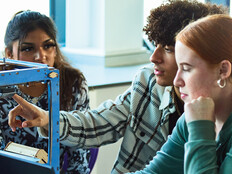In 2016, Anderson Elementary School in Bristol, Tenn., started a journey from a traditional school and library to a place of wonder and innovation, inspired by the idea of creating makerspaces.
That idea required changing an existing system. It also pushed me, as principal, to think through some questions: Where will we place a makerspace? How will we train the teachers to use the new technology? How will we find that space to create innovation? What concerns will students or parents have about this transformation? How will we fund this initiative?
Two years later, our school library includes a makerspace, and multiple classrooms are using technology to inspire and engage students. That engagement is crucial to boosting student achievement and improving teacher morale — two key goals behind the transformation effort.
The transformation began with a new vision statement that serves as a compass for our journey: “Learning and Leading to Create Our World.” It took two years to fine-tune and realize that vision. Change is a process. Two keys to transformation are patience with the process and inspiring collaboration. It also takes courage to invite teachers, students and parents into a change process.
So, a school has a vision. Now what? What does the vision look like in action? What does it sound like? How does it directly impact student achievement and growth?
A ‘Blank Slate’ for Boosting Student Engagement
Our makerspaces are designed to connect STEM career exploration to reading literacy through a systematic process. We implemented a weeklong after-school experience called Design Camp, where students could explore coding, VEX robots, STEM labs and art experiences. We followed a similar pattern to offer further opportunities during the day: During extended learning opportunities and weekly library classes, students investigate and apply rigorous technology and literacy skills across the curriculum.
Our library was under renovation when this journey began, which meant we had a blank canvas for designing the new space. We added high-top work tables, colorful stools, a Lego wall, and wheeled toolboxes for a career and technology lab. We created a café-style reading zone with colorful chairs and bookcases. Even with a shoestring budget, we designed a beautiful and inviting learning space for students to experience reading and apply problem-solving skills. We sought grant funding to add new technology.
Our first grant, through the Tennessee Valley Authority, provided $5,000 to expand the concept of one makerspace into a schoolwide initiative, with designated teachers who have expertise in coding, robotics, digital arts and STEM labs. We used the grant funds to create weekly labs for students in makerspaces where they used academic vocabulary, experienced performance-based learning opportunities and engaged in interactive labs with cross-curricular connections to math, science, engineering and career exploration.
MORE ON EDTECH: Read about how Cambridge Public Schools' computer science playground is helping STEM learning more tangible and applicable.
As a result of this project, students can:
- Participate in new STEM-focused makerspaces
- Complete an elementary career and interest survey
- Participate in personalized goal conversations that connect academic proficiency goals to career interests and readiness
- Access academic vocabulary, technology, science, engineering and math skills across the curriculum
- Meet personalized proficiency reading and math goals
- Participate in weekly makerspace labs
- Investigate coding and progression of coding skills
- Apply coding skills in robotics activities
- Write, film and produce school news updates
- Design and create using a 3D printer and industrial technology
100%
The percentage of students who told Macquarie University researchers they would like additional instruction involving 3D design and printing.
Source: Macquarie University, “Makerspaces in Primary School Settings,” September 2018
Encouraging Students to Dream and Be Lifelong Learners
I have often heard that children are our future. In reality, we are their future. The experiences students have in our classrooms every day shape their thoughts and feelings about learning. Research indicates that students who are engaged in career and technical education classes will stay in school and graduate at a higher rate. I have observed a similar phenomenon through the transformation of makerspaces.
Purpose, provision and promise are part of the process that ensures the schools we are creating and designing today result in amazing experiences and memories for the students we serve. We are learning every day how to continue our transformation and invite students to discover careers and interests they have not even dreamed about yet.











